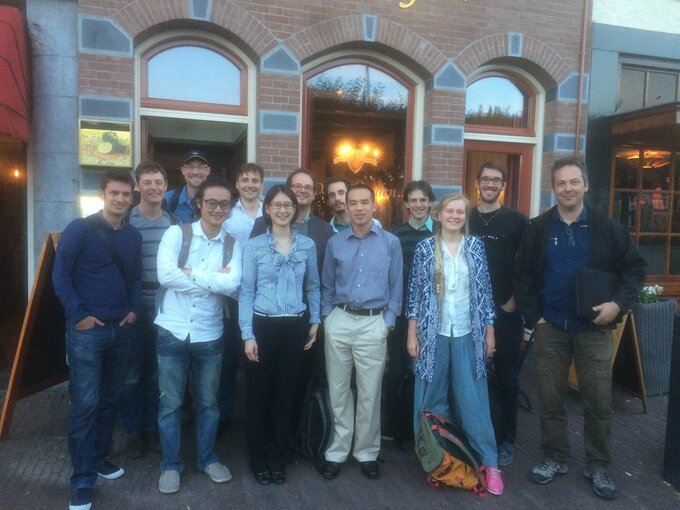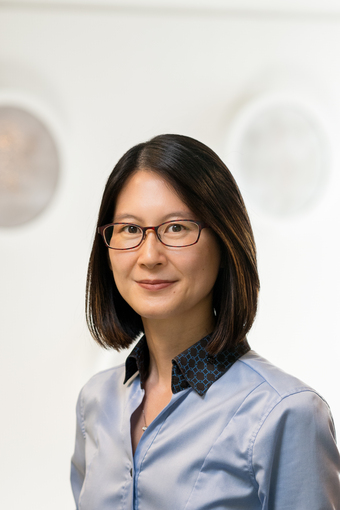Sherry Suyu erhält Berkeley-Preis 2021
Hohe Auszeichnung durch die Amerikanische Astronomische Gesellschaft
2020-07-30 – Nachrichten aus dem Physik-Department
Sherry H. Suyu wird mit dem Berkeley-Preis 2021 für die Leitung der H0LiCOW-Kollaboration geehrt, die die kosmische Expansionsrate mit Hilfe von Quasaren und Gravitationslinsen misst. Die jüngste Forschungsarbeit der Gruppe erschien im Juni 2020. Sie bestätigt, dass “lokale” Messungen der Expansionsrate nicht mit den Werten übereinstimmen, die man erhält, wenn man bestimmte Eigenschaften der kosmischen Mikrowellen-Hintergrundstrahlung des frühen Universums misst und dann mit Hilfe des kosmologischen Standardmodells auf die Gegenwart extrapoliert. Mit den Messungen, dem Modell oder mit beiden muss etwas nicht stimmen. Jedoch konnten weder Beobachter noch Theoretiker bisher herausfinden, was übersehen wurde.
Schauen wir uns die Abkürzung H0LiCOW genauer an, die tatsächlich ein verschachteltes Akronym darstellt. Sie steht für H0 Lenses in COSMOGRAIL’s Wellspring. “H0” (richtig geschrieben als H0 mit tiefgestellter Null, nicht dem Buchstaben O), ist die Hubble-Konstante, die aktuelle Expansionsrate des Universums. Linsen (engl.: „lenses“) beziehen sich auf Gravitationslinsen. Dies sind für gewöhnlich Galaxien, bei denen die enorme Schwerkraft einer Galaxie mit Milliarden von Sternen die Raumzeit so verzerrt, dass mehrere Bilder eines Hintergrundquasars entstehen. Bei dem Hintergrundquasar handelt es sich um ein supermassereiches Schwarzes Loch im Zentrum einer der Gravitationslinse gelegenen Galaxie, welches sich von umgebendem Gas, Staub und Sternen ernährt und dabei enorme Strahlung emittiert.

“COSMOGRAIL” ist das COSmological MOnitoring of GRAvItational Lenses, ein internationales Projekt zur Messung von Zeitverzögerungen in Gravitationslinsen-Quasaren, das eine Fülle (engl.: wellspring) an Daten liefert. Die Zeitverzögerung bezieht sich auf die Tatsache, dass Quasare in ihrer Helligkeit variieren; da das Licht von jedem Linsenbild einem leicht unterschiedlichen Weg vom Quasar zur Erde folgt, erscheinen Helligkeitsschwankungen in verschiedenen Bildern zu unterschiedlichen Zeiten. Aus diesen Unterschieden können die Astronomen die Geometrie der Raumzeit in der Linsengalaxie und, im Rückschluss, die kombinierte Masse der sichtbaren und dunklen Materie der Galaxie bestimmen. Uff!
Jedes Jahr wählen die drei Vizepräsidenten der AAS in Absprache mit dem Chefredakteur der AAS-Zeitschriften den Berkeley-Preisträger für eine verdienstvolle Forschungsarbeit aus, die in den vorangegangenen 12 Monaten veröffentlicht wurde. Als Reaktion auf die E-Mail von Vizepräsidentin Joan Schmelz, in der ihre Wahl als Berkeley-Preisträgerin 2021 mitgeteilt wurde, schrieb Suyu: “Vielen Dank für diese fantastische Nachricht! Es ist eine große Ehre, nicht nur für mich, sondern für das gesamte H0LiCOW-Team! Unsere Ergebnisse erforderten viele Jahre harter Arbeit, und wir freuen uns darauf, eine völlig unabhängige und wettbewerbsfähige Methode der Kosmologie zu etablieren. Ohne meine wunderbaren H0LiCOW-Mitarbeiter wäre all dies nicht möglich, und ich bin ihnen aufrichtig dankbar.“
Neben ihrer Tätigkeit als Forschungsgruppenleiterin am MPA und Assistenzprofessorin an der TUM ist Suyu auch Gaststipendiatin am Academia Sinica Institute of Astronomy and Astrophysics (ASIAA). Zu ihrem H0LiCOW-Team gehören Wissenschaftler an Institutionen in den Vereinigten Staaten, Europa, Japan und Taiwan. Im Jahr 2017 gewährte ihr der Europäische Forschungsrat ein Stipendium für die Durchführung einer neuen Studie über Supernova-Explosionen mit Gravitationslinsen: HOLISMOKES (HochOptimierte LInsenuntersuchungen von Supernovae, MikrolinsenObjekten und der Kinematik von Ellipsen und Spiralen). Suyu ist auch am Exzellenzcluster ORIGINS beteiligt, einer interdisziplinären Zusammenarbeit deutscher Institutionen, die die Entwicklung des Universums vom Urknall bis zur Entstehung von Leben untersucht.
Suyu erwarb 2001 ihren Bachelor of Science in Astrophysik an der Queen’s University, Kanada, und promovierte 2008 in Physik am Caltech. Danach folgten Postdoktorandenstellen an der Universität Bonn, Deutschland, der University of California, Santa Barbara, und der Stanford University. Seit 2013 ist sie Mitglied der Academia Sinica und seit 2016 ist sie gemeinsam am MPA und an der TUM tätig. Im Jahr 2018 war sie Emmy-Noether-Gaststipendiatin des Perimeter Institute in Waterloo, Ontario, Kanada. Sie hat mehr als 90 Forschungsartikel in Fachzeitschriften mit Peer-Review veröffentlicht.
Veröffentlichung
Links
- Webseite von Sherry H. Suyu (englisch)
- Homepage der H0LiCOW-Kollaboration (englisch)
- Lancelot M. Berkeley - New York Community Trust Prize for Meritorious Work in Astronomy (englisch) AAS Webpage about the Berkeley Prize
- YouTube-Video über H0LiCOW (englisch)
Verwandte Meldungen
- Hubble-Konstante: Messung mit Hilfe kosmischer Linsen – 2020-01-08
- Wie schnell expandiert das Universum? – 2019-09-12
- Spitzenforschung vom Nanodraht bis zur Supernova – 2017-12-13
- Der kosmische Blick um die Ecke – 2017-01-27
